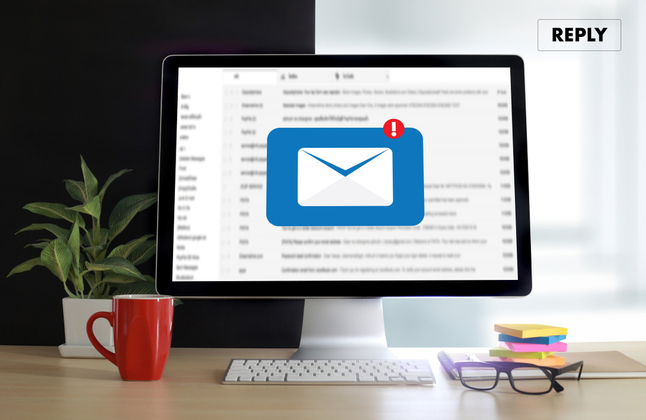
Here's something you may have experienced a couple of times. You work tirelessly to generate new leads, come up with the best prospecting strategy, and compose a great outreach email. You send the email to prospects expecting a high response rate, but you don't get any.
You then sit and wonder why you sent the email in the first place.
Don’t lose hope, that's why follow-up emails exist.
According to research, you have a 21% chance of receiving a response to a first follow-up email. However, subsequent follow-up emails increase those chances to 25%.
Most people feel a little uneasy when they think of writing a follow-up email. Our instincts usually tell us that if someone hasn't responded to our initial email, they are not interested and they may not like it if we disturb them again.
In this case, our instincts are usually wrong.
There are very few prospects that say "yes" the first, second, or third time. Statistics show that 80% of prospects respond "no" four times before eventually saying "yes."
But the thing is, most people give up after getting rejections four times. Those that follow up at least five times are able to convert leads into sales.
Sending follow-up emails is crucial, unless you like missing out on sales. If you want your emails to be as effective as possible, here's what you should do.
Before Following Up, Wait
Most people open emails the day they receive them. If they're going to reply, they will probably do it on the same day. It's quite safe to assume that if someone doesn't reply to your email the day you send it, they are not going to reply at all.
So, how long do you have to wait before sending the first follow-up email? Two to three days. And for each subsequent email after that, extend the wait period by a few days.
There are no hard and fast rules on the best way to approach this, but email marketing experts propose spacing your follow-up emails this way:
- Day 1: first follow-up email
- Day 3: second follow-up email
- Day 7: third follow-up email
- Day 14: fourth follow-up email
- Day 28: fifth follow-up email
- Day 58: sixth follow-up email
When you wait at least three days before sending a follow-up email, you give the person enough time to respond.
There are also different studies that tell us the best days for getting email responses. One popular study is in favor of Tuesday. Sending follow-up emails on weekends is a no-no.
It's also important to send follow-up emails at the right time. Make sure you send the emails between 10 a.m. and 11 a.m. in the recipient's time zone.
It's always a good thing to experiment, but you can use these tried-and-tested strategies until you come up with better ones. If you send daily follow-up emails, you may end up annoying your prospects and your emails may be marked as spam.
Create Powerful, Engaging Subject Lines

How many emails do you receive every day and don't read? 10? 20? Hundreds? I'm guessing it's a lot. There's no space that’s as crowded as an email inbox.
The people you're sending follow-up emails to get tons of emails every day. So, how do you get them to notice your emails, open them, and do what you’d like them to do?
You write a great subject line.
If you want your emails to be opened and read, make the subject lines captivating.
The subject line is the first thing your potential client will see before opening your email. Make sure it’s direct and sharp and clearly shows your intention. It must provide key information and explain the goal you’re trying to achieve.
Here are some examples of awesome email subject lines:
- "Hoping to help"
- "Getting tired of salespeople who don't give up?"
- "It's not late to get started"
- "Can you help me with this?"
- "Great meeting you today, I would like to share something else."
- "Would anything change your mind?"
- "You're not alone"
- "Let's cut to the chase"
- "Here's that information I promised you"
- "Do not open this email"
Just like a gatekeeper can stop a salesperson from getting to the manager, a subject line can prevent a prospect from opening an email. When prospecting via email, the recipient is the gatekeeper.
People receive an avalanche of emails every day and simply scan subject lines to assess urgency, worthiness, and interest. When you understand this, you’ll start writing better subject lines to make your emails stand out from the crowd.
Keep It Simple
The most effective emails are actually quite simple. You don't need to spend a lot of time creating an award-winning email. Brevity wins every time.
If you send someone a text, they will read it immediately. But if you send them an email, it may join the numerous unread emails in their inbox.
The trick is to keep it simple.
One thing that has a dramatic impact on email response rates is the reading grade level. In one email marketing study, emails written at a third grade reading level received most responses. Emails with short sentences and short words got a 53% response rate. Those written at a kindergarten level had a 46% response rate while those written at a high school level had a 45% response rate. Emails written at a college reading level had the worst response rate, at only 39%.
It's important to keep things positive, but make sure you don't get carried away. Flattery also works at times, but don't overdo it. Email length is also critical. The optimum length is 125 words. However, you shouldn't worry too much if you go beyond that as response rates only start to drop when you get to 2,000 words.
Make your follow-up emails simple, easy to read, and easy to respond to. You don't want to scare prospects by being overenthusiastic or too negative. Strike a balance.
Avoid Typos

It's very easy to make typos but very hard to recover from them. Typos make you look like an amateur and can be the main reason a sale sinks. But careless mistakes in emails are not always easy to avoid. It's a lot like losing weight. It seems very simple, but if everyone could do it, we would all be thin.
Here's the thing. Our eyes usually see what they want to see, so your email may still have mistakes even after you proofread. For example, if you read the phrase "Once upon a ...," your mind will automatically tell you that the next word is "time." However, you may have typed "tine" unknowingly.
Here are a few tips to help you make typos a thing of the past:
- After you write an email, read it out loud
- Be careful when writing emails as you would when writing handwritten notes
- Use your computer's spell checker but don’t rely on it
- Learn from your mistakes
A well-written email that is free of typos can make you look very professional. If you are not confident of your proofreading skills, have a colleague read the email once you’re done. You can also make the most of tools like ProWritingAid which do much more than your computer’s spell checker.
Include a Call to Action (CTA)
A call to action can be a button or hyperlinked text someone can click on to visit a website or a specific page. When you add one to your follow-up email, you compel readers to do more than just read. The right call to action makes it easy for the email recipients to respond.
In your email, include only one call to action and make sure it is specific about the action you want the reader to take. Be very clear about what you want and tell the reader what's in it for them.
Remember, there's a reason you're sending that follow-up message—to make a sale, generate business, or clarify something. A CTA is your arsenal; it’s what will separate your email from the rest. Use it to continue the conversation or interaction between you and your prospects.
Here are five tried-and-tested CTAs that will trigger action:
- Give us your feedback
- Complete our 4-minute survey
- See how your business benefits
- Start now, get results
- Take a survey
Set Yourself Up for Success When Writing Follow-Up Emails
Okay, so now you know it's important to write follow-up emails and how to go about writing them. But before you go, here are three very important things to remember.
1. You need to send follow-up emails consistently over a long period of time. Your patience will be rewarded.
2. Create a system. A good sales Customer Relationship Management (CRM) tool will help prevent embarrassing situations like duplicate emails.
3. Ensure your sales and marketing departments are aligned and clearly know their roles in follow-up.
One of the greatest lessons you will learn as you send follow-up emails is that prospects will buy when they are ready to buy. "Know your customer" is the first commandment of sales and the golden rule when it comes to creating follow-up emails.

